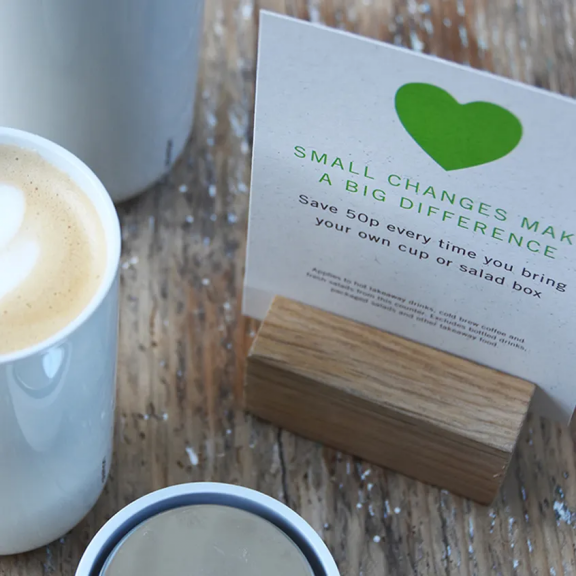
Sustainable commerce: five ways businesses can reduce their impact
With record high temperatures around the world, ‘Climate Change’ is well and truly back on the agenda.
Go back a few years and the ‘hot’ topic dominated the thoughts and minds of retailers and shoppers, alike. The phrase sustainable ecommerce became synonymous with best practice and suggested retailers were doing their bit to help save the planet.
However, just when many were taking positive steps to make a difference, the pandemic struck, meaning little else mattered.
Amazon and home deliveries increased; plastic screens and hand sanitiser were bought in bulk; supermarkets refused to take back empty shopping bags; sustainable ecommerce took a back seat.
Now, it’s back in the spotlight again - and more important for retailers to take seriously, than ever before.
Last year, e-Commerce sales totalled around $4.9 trillion US dollars across the globe, with forecasts of $7.4 trillion by 2025. Unsurprisingly, the pandemic helped quicken the move to digital retail, with 68 per cent of consumers quizzed in a poll last year agreeing that they had bought more online due to the pandemic.
Transparency about your business practices and supply chain
Just because your business is doing all it can to reduce its carbon footprint, doesn’t mean those along your supply chain are doing the same.
Today, customers want transparency. They want to understand where your products are sourced; the ingredients in them; how they are made and where. Are those making the products getting a fair wage and are their working conditions up to scratch?
A recent survey by Avery Dennison Corporation in its 2021 Digital Consumer Behaviour report found 60 per cent of those questioned wanted more transparency about the production journey their clothes had been on, so they could make more informed, ethical purchasing decisions.
Fashion brand Patagonia’s Supply Chain Environmental Responsibility Program is seen as one of the leaders in the field of this type of transparency.
The business implements the initiative at supplier facilities all over the world to cover a broad range of impact areas, including environmental management systems, chemicals, water use, water emissions, energy use, greenhouse gases, other air emissions and waste. Suppliers are encouraged to demonstrate environmental excellence by implementing better and best practices, working with the company to make improvements where needed.
Not only does this help eliminate the environmental impacts of manufacturing its products, but it lets customers see for themselves the various supply chains and impacts these have on the globe and allows them to make purchase decisions based on their learnings.
Can you show how your products are made, where the materials are sourced and put together? Can you work closer with the factories to improve their own environmental credentials, or farms that produce cotton, for instance? Mapping everything out from the source is incredibly complex and challenging. But get it right and you will improve your own sustainability standing and have many interesting stories to tell that can help re-shape your brand ethos and attract a whole new legion of customers.
Reduce packaging and waste
Around 4.2 billion parcels were sent in the UK in 2020/21 – a whopping increase of over 1.3 billion parcels on the year before.
Data collected by US start-up LimeLoop estimates around 165 billion packages are shipped in the US each year, with the cardboard equating to roughly 1 billion trees.
The figures are truly shocking. However, unsurprisingly, just the tip of the iceberg.
Many businesses have grown so quickly during COVID, they simply haven’t had the time to think about their carbon footprint in this way.
However, plenty of others are making great inroads into doing something about it such as giving customers the choice of reusing packages.
Ecommerce companies using LimeLoop packaging, for instance, give consumers the option of the product being sent in used packaging during checkout. Customers can resend the vinyl packaging back after delivery. They have a 10-year life, can be used 2,000 times and are estimated to save 1,300 trees and around 2 million gallons of water for every 100 deliveries.
Digital cosmetics brand Adore Beauty is one of a number of businesses using new warehouse management software to cut down on its packaging through ‘volumetric calculation.’ The company scanned 13,000 products to get the dimensions and weights to ensure the smallest box was used with each order, minimising the environmental impact of the company while saving money on shipping costs and taking up less warehouse space.
Cutting back on waste is another area that digital retailers should explore. SQLI customer Daylesford, an organic and sustainable food and homeware business, avoid waste from spoilage by ordering fresh fruit and vegetables on a daily basis and sending bulk containers to the stores for use in their kitchens.

Plastic not fantastic
Despite massive improvements from retailers when it comes to plastic, an estimated 4.9 million metric tons of plastic are placed on the market each year, of which three-quarters become waste.
More companies are looking at alternative ways of packing and protecting their products, using renewable materials such as cornstarch-based packing peanuts which can dissolve in water.
Hundreds of businesses have joined the Ellen MacArthur Foundation’s New Plastic Economy Global Commitment with the aim to create a circular economy for plastic with three main actions: Eliminate (eliminate all problematic and unnecessary plastic items; Innovate (innovate to ensure plastics we need are reusable, recyclable or compostable; Circulate (circulate all the plastic items we use to keep them in the economy and out of the environment).
Last year, in an interview with SQLI, former River Island CEO Ben Lewis said: “Plastics are obviously an issue to customers – and cause a lot of division. I really think we should be using recyclable plastic and I’m in favour of legislation that would ensure companies and individuals are forced, or highly-incentivised, to use recycled plastics so we are not damaging the environment or natural resources.”
Can you look at alternatives to bubble-wrap and similar to protect your products when sending out? Can you join any of the many initiatives now taking part around the world and take on board what other businesses are doing?

Get on the recycle trail
We live in the age of fast fashion consumerism – the process of designing, manufacturing and selling items quickly and for as little as possible. This means garments can be less robust on top of the fact customers are more likely to cast them out after a few wears.
When it costs more to repair a washing machine or TV than replace it with a new one, it’s hard for some to justify the expenditure. However, according to Green Story Environmental study, if everybody bought just one used item each year instead of buying new, it would save 449million pounds (lbs) of waste.
Now, more companies are on the recycle trail - encouraging their customers to return or reuse their goods to prevent them going onto landfill sites.
Make a positive change
Sometimes a company simply wants to go that extra mile (and for good reasons) or give something back. Could you bring in a method of off-setting your carbon footprint or actively do something to make your brand more visibly sustainable through its practices?
In July 2020, Apple announced it would become carbon neutral across the business, manufacturing supply chain and product life cycle by 2030. Steps include the use of low carbon and recycled materials in its products and actively working to remove carbon from the atmosphere.
Shoe brand TOMS invests a third of its profits into grassroots good, including cash grants and partnerships with community organisations, to drive sustainable change.
Whereas 4ocean sell sustainable jewellery, apparel and other items – and with every product they sell, will remove one pound of trash from the ocean, rivers and coastlines through their full-time crews.
What could you do differently as a business?
In summary
While the push towards more sustainable retail never really went away, it’s certainly back on the table. And with governments around the world signing up to various initiatives and agendas to be plastic free, or carbon neutral, by certain dates, digital retailers must take steps to move onto a more sustainable business model.
Think:
- Recycle: Can you encourage your customers to return your products when they no longer need or want them? Can you recycle these or donate them rather than send to landfill?
- Packaging and waste: Can you find alternatives to cardboard, or order less but more frequently to cut down on what is thrown away?
- Supply chain transparency: Do you know each step of the supply chain? Can you do more to help factories or farms in other countries become more sustainable themselves?
- Plastics: Can you use parchment paper to wrap food? Different materials to protect clothes? Encourage customers to reuse?
- Make a change: Can you give something back to offset your carbon footprint? Can you donate profits to charities actively working in an area that you would like to help in?
The above is just a snapshot of what digital retailers are doing now in their bid to become more sustainable. There is a host of other areas to explore, from how to cut back on returns and how your goods are transported, to how your bricks and mortar stores are run.
Consumers are becoming more aware of the damage their shopping habits are doing to the world and will actively support those brands they see are making real strides to do something different or positive.
Businesses, consumers, governments and charities must work together to take responsibility for the damage being caused – and for digital retailers, the time to act is now if that haven’t already!

